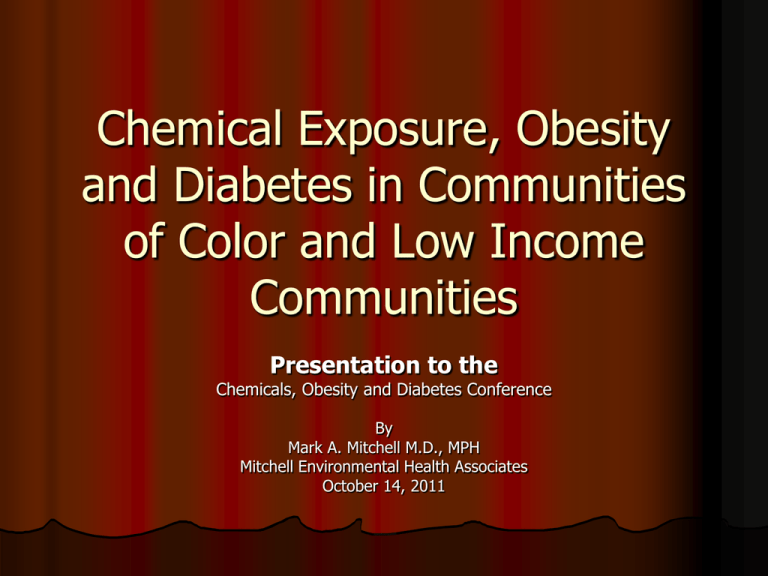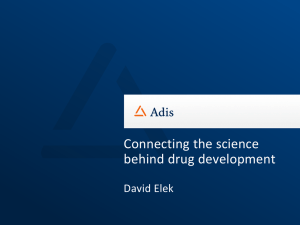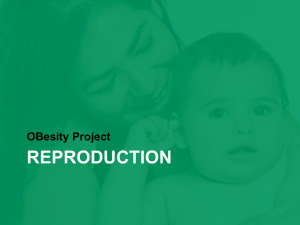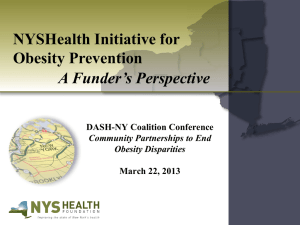Chemical Exposure, Obesity and Diabetes in
advertisement

Chemical Exposure, Obesity and Diabetes in Communities of Color and Low Income Communities Presentation to the Chemicals, Obesity and Diabetes Conference By Mark A. Mitchell M.D., MPH Mitchell Environmental Health Associates October 14, 2011 Thanks to the sponsors Environmental Health Strategy Center Colby College Environmental Studies Program and Goldfarb Center for including this important topic Chemicas Obesity and Diabetes Conference October 14, 2011 2 Conflict Declaration I Have No Commercial Interests in Products or Services Presented Chemicas Obesity and Diabetes Conference October 14, 2011 3 Overview I will present: Definition of environmental justice Link between EJ and obesogens Prevalence of obesity in Blacks and Latinos Chemical exposures in Blacks and Latinos Increased vulnerability factors How low income people can decrease risks Chemicas Obesity and Diabetes Conference October 14, 2011 4 What is Environmental Justice? The U.S. Environmental Protection Agency defines Environmental Justices as: ”The fair treatment and meaningful involvement of all people regardless of race, color, national origin, or income with respect to the development, implementation, and enforcement of environmental laws, regulations, and policies.” Chemicas Obesity and Diabetes Conference October 14, 2011 5 What is Environmental Justice? Continued Fair treatment means that no group of people, including racial, ethnic, or socioeconomic group should bear a disproportionate share of the negative environmental consequences resulting from industrial, municipal, and commercial operations or the execution of federal, state, local, and tribal programs and policies.” Chemicas Obesity and Diabetes Conference October 14, 2011 6 Environmental Justice is About Health Environmental Hazards Disproportionately Located in Low-income and Black and Latino Neighborhoods Contributes to Health Disparities Environmental Injustice is Institutional Racism EJ is about Stopping Environmental Injustice and Changing Environmental Policy to reduce Health Effects Chemicas Obesity and Diabetes Conference October 14, 2011 7 Point Source Air Pollution Emissions in Connecticut 2000 Chemicas Obesity and Diabetes Conference October 14, 2011 8 What Does Environmental Justice Have to do With Obesogens? High and disproportionate exposure Increased vulnerability Probable increased effects Chemicas Obesity and Diabetes Conference October 14, 2011 9 State-specific Prevalence of Obesity* Among U.S. Adults, by Race/Ethnicity, NHANES 2006-2008 White non-Hispanic (*BMI 30) Chemicas Obesity and Diabetes Conference October 14, 2011 10 State-specific Prevalence of Obesity* Among U.S. Adults, by Race/Ethnicity, NHANES 2006-2008 Hispanic (*BMI 30) Chemicas Obesity and Diabetes Conference October 14, 2011 11 State-specific Prevalence of Obesity* Among U.S. Adults, by Race/Ethnicity, NHANES 2006-2008 Black non-Hispanic (*BMI 30) Chemicas Obesity and Diabetes Conference October 14, 2011 12 State-specific Prevalence of Obesity* Among U.S. Adults, by Race/Ethnicity, 2006-2008 Black non-Hispanic White non-Hispanic Hispanic (*BMI 30) Chemicas Obesity and Diabetes Conference October 14, 2011 13 Prevalence of obesity, by region and race/ethnicity, 2006-2008 Blacks had the highest prevalence, followed by Hispanics, and Whites For Blacks Overall prevalence of obesity—35.7% − Prevalence ranged from 23.0% (New Hampshire) to 45.1% (Maine) − Chemicas Obesity and Diabetes Conference October 14, 2011 14 Summary (Cont’d) For Hispanics − Overall prevalence of obesity—28.7% − Lower prevalence was observed in the Northeast For Whites − Overall prevalence of obesity—23.7% − Higher prevalences were found in the Midwest and South Chemicas Obesity and Diabetes Conference October 14, 2011 15 Common Environmental Justice Issues Linked to Chemical Policy Land and Solid Waste Pollution Landfills and Dumps Brownfields Hazardous Waste Abandoned Storage Drums of Chemicals PCB’s in Soil TCE Contaminated Soil Air Toxics Trash, Sewage Sludge and Other Incinerators Indoor air contaminants Water Contamination Chemical and Pharmaceutical Sewage Contamination Fish Contamination with PCB’s Sewage Sludge Compost/Pellets Chemicas Obesity and Diabetes Conference October 14, 2011 16 Common Environmental Justice Issues Linked to Chemical Policy Industrial Pollution Local Business Toxins Cement Kilns Agricultural Pesticides Toxic Release Inventory (TRI) Listed Facilities Refineries Chemical Plants Plastics/Rubber Factories Pharmaceutical Plants Industrial or Chemical Fires/Explosions/Spills Chemicas Obesity and Diabetes Conference October 14, 2011 17 Common Environmental Justice Issues Linked to Chemical Policy Consumer Product Exposures Discount Store Selling Toxic Toys Home Pesticides Cosmetics/Personal Care Products BPA in canned food and drink containers Lead in tire weights Legacy lead in paint Chemicas Obesity and Diabetes Conference October 14, 2011 18 Ethnic Cosmetic Toxicants Hair relaxers: sometimes contain placenta (linked with early puberty in children, toddlers) Chemicas Obesity and Diabetes Conference October 14, 2011 19 Exposure Over the Chemical Lifecycle Production Transportation and storage canned goods, lead tire weights Disposal accidents, fires, spills Use fenceline exposure, maintenance incinerators, landfills (LBW) Legacy PCB’s, DDT, lead based paint Chemicas Obesity and Diabetes Conference October 14, 2011 20 Vulnerability Malnutrition Lead absorbtion PBT’s Psychosocial stress Income disparity Chemicas Obesity and Diabetes Conference October 14, 2011 21 What Can Low Income People Do? Wash fruits and vegetables to reduce pesticides If they can’t eat organic, then low-fat foods, especially milk, meats and eggs Look for hormone and antibiotic free meat and eggs Don’t microwave in plastic containers or allow plastic wrap to touch hot food Look for BPA-free plastic water bottles and baby bottles Don’t buy PVC plastic containers Eat fresh, frozen, or glass bottled rather than canned foods and drinks Join organizations that work on chemical policy Chemicas Obesity and Diabetes Conference October 14, 2011 22 Summary Defined environmental justice Link between EJ and obesogens Higher obesity rates in Blacks and Latinos Higher chemical exposures in Blacks and Latinos Increased vulnerability factors How low income people can decrease risks Chemicas Obesity and Diabetes Conference October 14, 2011 23 Contact information Mark A. Mitchell M.D., MPH Mitchell Environmental Health Associates mmitchell@enviro-md.com (860) 794-9497 Chemicas Obesity and Diabetes Conference October 14, 2011 24 Table. Prevalence of obesity, by region and race/ethnicity, 2006-2008 Non-Hispanic white Non-Hispanic black Hispanic Both sexes 23.7 35.7 28.7 Men 25.4 31.6 27.8 Women 21.8 39.2 29.4 Both sexes 22.6 31.7 26.6 Men 25.0 26.5 26.9 Women 20.0 36.1 26.0 Both sexes 25.4 36.3 29.6 Men 27.0 32.1 29.7 Women 23.8 40.1 29.2 Both sexes 24.4 36.9 29.2 Men 26.3 32.6 28.3 Women 22.5 40.6 29.7 Both sexes 21.0 33.1 29.0 Men 22.1 34.1 27.3 Women Conference 19.8 Chemicas Obesity and Diabetes 32.0 Total Northeast Midwest South West October 14, 2011 30.4 25








